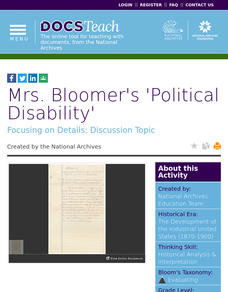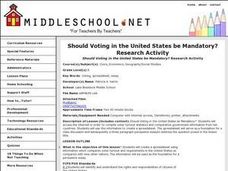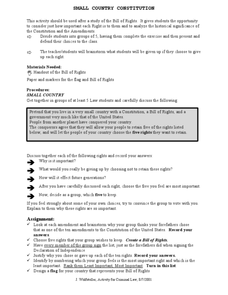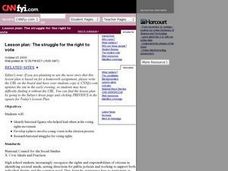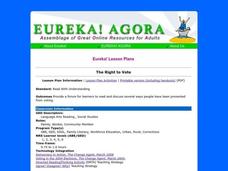iCivics
Students Power Elections
A Students Power Elections resource guide provides would-be voters with the guidance they need to become voters. Included in the packet is information about voter registration and voting, how to research candidates and ballot measures,...
PBS
Civic Engagement and How Students Can Get Involved
There is no age limit on civic engagement. Even if your pupils are not old enough to vote, they are old enough to get involved. Show them how with a PBS activity that underscores the importance of civic participation and models ways...
Facing History and Ourselves
Interracial Democracy
Radical Reconstruction, the 10-year period referred to after Congress passed the Reconstruction Act of 1867, saw the establishment of manhood suffrage, men voting without any racial qualifications. Southern states also rewrote their...
DocsTeach
Suffrage Photograph Analysis
Votes for women! Young scholars use images to explore the suffrage movement and its impact on the United States. Historians work in groups or pairs to interpret the photograph, complete a worksheet, and discuss how their opinions of the...
DocsTeach
Mrs. Bloomer's 'Political Disability'
It's hard to believe that women had to argue for the right to vote a mere 100 years ago. Today, young historians can examine their case left behind in primary sources. Using a letter from a woman who claimed she should be able to vote...
National Woman's History Museum
Seneca Falls and Suffrage: Teaching Women's History with Comics
As part of the study of women's history, young scholars examine Chester Comix's strips about the Seneca Falls Convention and four 19th century leaders in the struggle for equal rights. After researching other elements of the Suffrage...
National Woman's History Museum
Ida B. Wells: Suffragist and Anti-Lynching Activist
Suffragette, investigative journalist, and civil rights activist Ida B. Wells is the focus of a lesson that has young historians study the work of this amazing woman. Scholars watch a video biography of Wells, read the text of her speech...
Constitutional Rights Foundation
Winner-Take-All: The Two-Party System
Two's company, three's a crowd. High school historians learn about the Electoral College, a two-party, winner-take-all voting system in the United States. The lesson explains the pros and cons of the two-party system, roadblocks for...
Center for History Education
Democratic Ideas of the 1776 Maryland Constitution
1776 was a year of political upheaval in the American colonies. Academics examine the Maryland Constitution to understand the desire to break with Great Britain. Young historians learn about Maryland's efforts to extend rights to its...
Equality and Human Rights Commission
Taking Action
The Universal Declaration of Human Rights passed in 1948 when the majority of members of the United Nations voted in favor of the resolution. Scholars use their knowledge of human rights to determine ways they personally can help promote...
Walt Disney Company
Elizabeth Started All the Trouble
Elizabeth Cady Stanton was a famous suffragette that paved the way for equal rights for women. Readers respond to before, during, and after reading questions based on her story. The resource is a great addition to a lesson during...
EngageNY
Grade 11 ELA Module 2: Unit 2, Lesson 3
What is the distinction between rights and equality? Scholars continue their analysis of "An Address by Elizabeth Cady Stanton" using the third instructional activity from the 14-part Grade 11 ELA Module 2: Unit 2 series. Pupils complete...
Curated OER
Be a Responsible Citizen: Vote!
Students explore American citizens' rights and responsibilities through group research on the Internet and develop a presentation for the class.
Curated OER
Laws of Civil Rights
Students investigate the Civil Rights Act of 1964. In this segregation lesson, students explore the rights that were guaranteed by the legislation as well as attempts by southerners to stop African Americans from voting. Students...
Curated OER
Inspiration for and Application of the Bill of Rights
Students examine individual rights. In this case law lesson, students discuss the from and function of the Bill of Rights prior to investigating several cases that deal with Constitutional rights. Students discuss the outcome of the...
Curated OER
Should Voting in the United States be Mandatory? Research Activity
Eighth graders research how many voters actually vote in the U.S. and nine other nations. They create a spreadsheet using this information and write a persuasive essay.
Curated OER
Responses to Discrimination During the Civil Rights Period
Students examine the effects of discrimination. In this American Civil Rights Movement lesson, students participate in a classroom activity that requires them to personally feel the effects of discrimination. Students then explore...
Curated OER
The Constitution and The Bill of Rights
Studnets explore the events and issues surrounding the Constitutional Convenetion and the Bill of Rights through web-sites interacting with such topics as the framers, court cases, games and more.
Curated OER
Right to vote...in the wrong place
Students create a presentation for other class members or for a local citizens' group explaining how they can guard ensure voter rights. Students research the Ohio Secretary of State's stand on provisional voting rules.
Curated OER
Why Vote?
Students design a ballot slip for student voting. They create a slogan and political brochure.
Curated OER
Small Country Constitution
Students pretend they live in a very small country with a Constitution, and Bill of Rights, like that of the US. People from another planet conquer the country, but allow them to retain five rights. They choose the five rights they want...
Curated OER
Comparing Women's History: Venn Diagram
Learners compare and contrast women's rights before and after 1909. They use the provided Venn Diagram to compare similarities and differences they've noted from class lectures or readings. This worksheet can be emailed, printed, or used...
Curated OER
The Struggle For The Right To Vote
Students identify historical figures who helped lead others in the voting rights movement, and research historical struggles for voting rights. They develop plans to involve young voters in the election process.
Curated OER
The Right to Vote
Students are provided a form for learner to read and discuss several ways people have been prevented from voting. Students relate what they know and discovered about voting rights for different population of people. They establish a...
Other popular searches
- Voting Rights Movement
- Voting Rights Act
- 1965 Voting Rights
- Minority Rights and Voting
- America and Voting Rights
- America Voting Rights
- Voting Rights Act 1965
- Voting Rights History
- Voting Rights Act of 1965
- Expanding Voting Rights
- Voting Rights of Women
- History of Voting Rights




